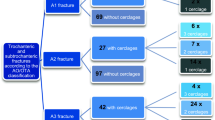Abstract
Introduction
The aim of this study was to evaluate the effect on union results of the application of cerclage cable around the lateral femoral wall (LFW) in postoperative fracture displacement.
Patients and methods
A retrospective evaluation was made of all the cases of reverse intertrochanteric fractures over a 7-year period in a trauma center. The study included 69 fractures treated with intramedullary nailing. The age of the patients, postoperative reduction quality and complications such as mechanical failure and non-union (1.4%) were obtained from the medical records. Changes in the neck-shaft angle, the amount of LFW displacement and telescoping of proximal femoral nail antirotation blades and lag screws were measured on anteroposterior and lateral radiographs. The functional evaluation of the Harris Hip Score was recorded at the final follow-up examination.
Results
The mean age of the patients was 56.31 years (range 18–93 years). Closed reduction was applied in 37 (53.7%) cases, open reduction in 10 (14.5%) and with cerclage cable in 22 (31.8%). Mechanical failure developed in 8 (11.5%) cases where cerclage cable was not used. In 2 of these 8 cases, open reduction was successful. In the patients where cerclage cable was applied, no mechanical failure developed and no case underwent revision surgery. In the cases where cerclage cable was not used, a significantly higher rate of telescoping was found. (p = 0.001). The application of cerclage cable was seen to significantly reduce the amount of LFW displacement (2.23 mm vs 8.86 mm) and shorten the time to partial weight bearing (p = 0.000).
Conclusion
In reverse intertrochanteric fractures, the application of circumferential cerclage cable with cephalomedullary nailing contributes to primary stability and accelerates mobilization. Therefore, it can be considered a good option. It reduces the risk of failure internal fixation for intertrochanteric fracture.




Similar content being viewed by others
References
Haidukewych GJ, Israel TA, Berry DJ (2001) Reverse obliquity fractures of the intertrochanteric region of the femur. J Bone Joint Surg Am 83-A:643–650
Sadowski C, Lubbeke A, Saudan M, Riand N, Stern R, Hoffmeyer P (2002) Treatment of reverse oblique and transverse intertrochanteric fractures with use of an intramedullary nail or a 958 screw-plate: a prospective, randomized study. J Bone Joint Surg 84:372–381
Kuzyk PR, Lobo J, Whelan D, Zdero R, McKee MD, Schemitsch EH (2009) Biomechanical evaluation of extramedullary versus intramedullary fixation for reverse obliquity intertrochanteric fractures. J Orthop Trauma 23(1):31–38
Boopalan PR, Oh JK, Kim TY, Oh CW, Cho JW, Shon WY (2012) Incidence and radiologic outcome of intraoperative lateral wall fractures in OTA 31A1 and A2 fractures treated with cephalomedullary nailing. J Orthop Trauma 26(11):638–642
Palm H, Jacobsen S, Sonne-Holm S, Gebuhr P, Hip Fracture Study Group (2007) Integrity of the lateral femoral wall in intertrochanteric hip fractures: an important predictor of a reoperation. J Bone Joint Surg Am 89(3):470–475
Ma Z, Chang SM (2014) Letter to the editor: where is the lateral femoral wall? Int Orthop 38(12):2645–2646
Hsu CE, Chiu YC, Tsai SH, Lin TC, Lee MH, Huang KC (2015) Trochanter stabilising plate improves treatment outcomes in AO/OTA 31-A2 intertrochanteric fractures with critical thin femoral lateral walls. Injury 46(6):1047–1053
Studer P, Suhm N, Wang Q, Rosenthal R, Saleh HA, Jakob M (2015) Displaced trochanteric fragments lead to poor functional outcome in pertrochanteric fractures treated by cephalomedullary nails. Injury 46(12):2384–2388
Kim Y, Bahk WJ, Yoon YC, Cho JW, Shon WY, Oh CW, Oh JK (2015) Radiologic healing of lateral femoral wall fragments after intramedullary nail fixation for A3.3 intertrochanteric fractures. Arch Orthop Trauma Surg 135(10):1349–1356
Yun HH, Lee YI, Kim KH, Yun S (2015) Use of auxiliary locking plates for the treatment of unstable pertrochanteric femur fractures. Orthopedic 38(5):305–309
Ban I, Birkelund L, Palm H, Brix M, Troelsen A (2012) Circumferential wires as a supplement to intramedullary nailing in unstable trochanteric hip fractures: 4 reoperations in 60 patients followed for 1 year. Acta Orthop 83(3):240–243
Hoskins W, Bingham R, Joseph S, Liew D, Love D, Bucknill A, Oppy A, Griffin X (2015) Subtrochanteric fracture: the effect of cerclage wire on fracture reduction and outcome. Injury 46(10):1992–1995
Tomás J, Teixidor J, Batalla L, Pacha D, Cortina J (2013) Subtrochanteric fractures: treatment with cerclage wire and long intramedullary nail. J Orthop Trauma 27(7):e157–e160
Park SY, Yang KH, Yoo JH, Yoon HK, Park HW (2008) The treatment of reverse obliquity intertrochanteric fractures with the intramedullary hip nail. J Trauma 65(4):852–857
Vidyadhara S, Rao SK (2007) One and two femoral neck screws with intramedullary nails for unstable trochanteric fractures of femur in the elderly–randomised clinical trial. Injury 38:806–814
Cleveland M, Bosworth DM, Thompson FR, Wılson HJ Jr, Ishızuka T (1959) A ten-year analysis of intertrochanteric fractures of the femur. J Bone Joint Surg Am 41-A:1399–1408
R Core Team (2016) R: a language and environment for statistical computing. R Foundation for Statistical Computing, Vienna, Austria. ISBN 3-900051-07-0. http://www.R-project.org/
Min WK, Kim SY, Kim TK, Lee KB, Cho MR, Ha YC, Koo KH (2007) Proximal femoral nail for the treatment of reverse obliquity intertrochanteric fractures compared with gamma nail. J Trauma 63(5):1054–1060
Matre K, Havelin LI, Gjertsen JE, Vinje T, Espehaug B, Fevang JM (2013) Sliding hip screw versus IM nail in reverse oblique trochanteric and subtrochanteric fractures. A study of 2716 patients in the Norwegian Hip Fracture Register. Injury 44(6):735–742
Gupta RK, Sangwan K, Kamboj P, Punia SS, Walecha P (2010) Unstable trochanteric fractures: the role of lateral wall reconstruction. Int Orthop 34(1):125–129
Babst R, Renner N, Biedermann M, Rosso R, Heberer M, Harder F, Regazzoni P (1998) Clinical results using the trochanter stabilizing plate (TSP): the modular extension of the dynamic hip screw (DHS) for internal fixation of selected unstable intertrochanteric fractures. J Orthop Trauma 12(6):392–399
Langford J, Pillai G, Ugliailoro AD, Yang E (2011) Perioperative lateral trochanteric wall fractures: sliding hip screw versus percutaneous compression plate for intertrochanteric hip fractures. J Orthop Trauma 25(4):191–195
Nherera L, Trueman P, Horner A, Watson T, Johnstone AJ (2018) Comparison of a twin interlocking derotation and compression screw cephalomedullary nail (InterTAN) with a single screw derotation cephalomedullary nail (proximal femoral nail antirotation): a systematic review and meta-analysis for intertrochanteric fractures. J Orthop Surg Res 2(13):46
Afsari A, Liporace F, Lindvall E, Infante A Jr, Sagi HC, Haidukewych GJ (2009) Clamp-assisted reduction of high subtrocanteric fractures of the femur. J Bone Joint Surg (Am) 91(8):1913–1918
Kennedy MT, Mitra A, Hierlihy TG, Harty JA, Reidy D, Dolan M (2011) Subtrochanteric hip fractures treated with cerclage cables and long cephalomedullary nails: a review of 17 consecutive cases over 2 years. Injury 42(11):1317–1321
Honkonen SE, Vihtonen K, Jarvinen MJ (2004) Second generation cephalo medullary nails in the treatment of reverse obliquity intertrochanteric fractures of the proximal femur. Injury 35:179–183
Al-yassari G, Langstaff RJ, Jones JW, Al- Lami M (2002) The AO/ASIF proximal femoral nail (PFN) for the treatment of unstable trochanteric femoral fracture. Injury 33(5):395–399
Ozkan K, Eceviz E, Unay K, Tasyikan L, Akman B, Eren A (2011) Treatment of reverse oblique trochanteric femoral fractures with proximal femoral nail. Int Orthop 35(4):595–598
Wei J, Qin DA, Guo XS (2015) Curative effect analysis on proximal fermoral nail antirotation for the treatment of femoral intertrochanteric fracture and integrity of lateral trochanteric wall. Zhongguo Gu Shang 28(6):572–575
Angelini A, Battiato C (2016) Combination of low-contact cerclage wiring and osteosynthesis in the treatment of femoral fractures. Eur J Orthop Surg Traumatol 26(4):397–406
Müller T, Topp T, Kühne CA, Gebhart G, Ruchholtz S, Zettl R (2011) The benefit of wire cerclage stabilisation of the medial hinge in intramedullary nailing for the treatment of subtrochanteric femoral fractures: a biomechanical study. Int Orthop 35(8):1237–1243
Gao YS, Guo YJ, Yu XG, Chen Y, Chen C, Lu NJ (2018) A novel cerclage wiring technique in intertrochanteric femoral fractures treated by intramedullary nails in young adults. BMC Musculoskelet Disord 6(19):359
Fogagnolo F, Kfuri M Jr, Paccola CA (2004) Intramedullary fixation of pertrochanteric hip fractures with the short AO-ASIF proximal femoral nail. Arch Orthop Trauma Surg 124(1):31–37
Eberle S, Gabel J, Hungerer S, Hoffmann S, Pätzold R, Augat P, Bühren V (2012) Auxiliary locking plate improves fracture stability and healing in intertrochanteric fractures fixated by intramedullary nail. Clin Biomech (Bristol, Avon) 27(10):1006–1010
Biber R, Bail HJ, Stedtfeld HW (2013) Lateral cortical notching in specific cases of delayed unions or nonunions after intertrochanteric and reversed fractures. Arch Orthop Trauma Surg 133:495–501
Tomás-Hernández J, Núñez-Camarena J, Teixidor-Serra J, Guerra-Farfan E, Selga J, Antonio Porcel J, Andrés-Peiró JV, Molero V (2018) Salvage for intramedullary nailing breakage after operative treatment of trochanteric fractures. Injury 49(Suppl 2):S44–S50
Perren SM, Fernandez Dell’Oca A, Lenz M, Windolf M (2011) Cerclage, evolution and potential of a Cinderella technology. An overview with reference to periprosthetic fractures. Acta Chir Orthop Traumatol Cech 78(3):190–199
Apivatthakakul T, Phaliphot J, Leuvitoonvechkit S (2013) Percutaneous cerclage wiring, does it disrupt femoral blood supply? A cadaveric injection study. Injury 44(2):168–174
Author information
Authors and Affiliations
Corresponding author
Ethics declarations
Conflict of interest
The authors declare that they have no competing interests.
Rights and permissions
About this article
Cite this article
Imerci, A., Aydogan, N.H. & Tosun, K. The effect on outcomes of the application of circumferential cerclage cable following intramedullary nailing in reverse intertrochanteric femoral fractures. Eur J Orthop Surg Traumatol 29, 835–842 (2019). https://doi.org/10.1007/s00590-018-2356-y
Received:
Accepted:
Published:
Issue Date:
DOI: https://doi.org/10.1007/s00590-018-2356-y




